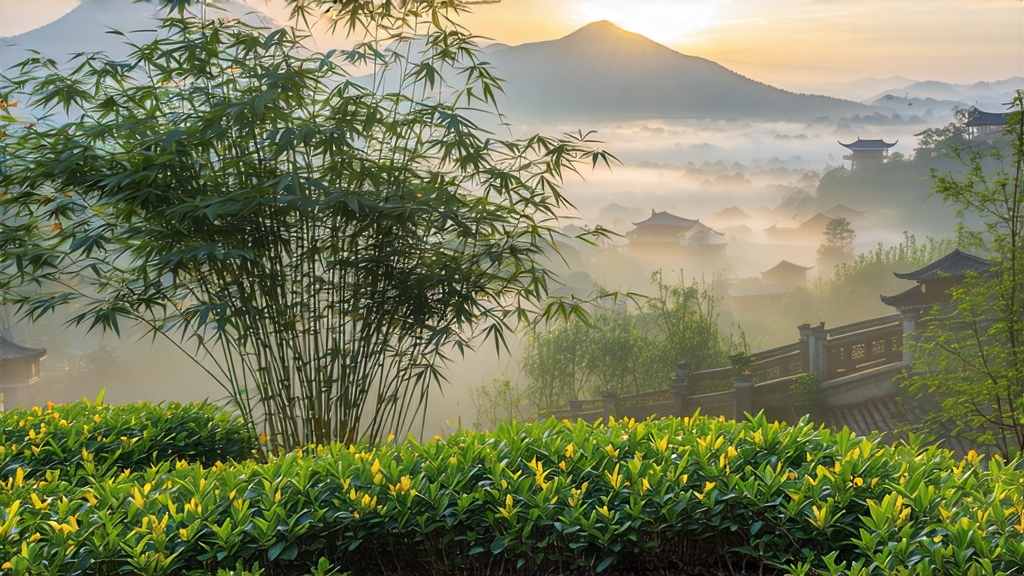
Tucked high on the northern shoulder of the Sichuan Basin, where the Min River carves a gorge through 1,500-year-old sandstone, the Meng Ding range has been cloaked in cloud since the Tang dynasty. It was here, in 724 CE, that the Buddhist monk Gan Lu (“Sweet Dew”) planted the first garden whose spring buds would later be carried by fast horse to Chang’an, sealed with wax and yellow silk, and laid before the Son of Heaven. The court scribes listed it simply as huang ya—“yellow bud”—but the name Meng Ding Huang Ya has since become the most coveted sub-species of China’s least-understood tea family. While green tea is celebrated for its freshness and pu-erh for its ageability, yellow tea occupies a liminal realm: the leaf is deliberately kept alive, wrapped and steamed until the green is persuaded to mellow into the color of antique ivory. The result is a liquor that tastes like mountain orchid dipped in warm honey, a flavor that once disappeared from the world market for half a century and is only now being coaxed back into the light.
Meng Ding Huang Ya is not a single clone but a micro-ecology of three local cultivars—Meng Ding #9, #16 and the ancient-seed “Small-Leaf Yellow”—all growing between 800 m and 1,400 m on north-facing terraces. The mountain’s own climate performs the first step of yellowing: fog at dawn traps moisture under the leaf, slowing photosynthesis and concentrating the amino acid theanine. Picking begins on the first day after the spring qingming festival, when each bud still wears its winter down and is exactly 2.2 cm long—short enough to stand upright on a fingertip. A master picker can gather only 600 g in a day, the exact yield needed for 100 g of finished tea after the successive losses of withering, firing, wrapping and final sorting.
The craft sequence is known as “sealed yellowing” (men huang), a technique that vanished during the 1930s wars and was re-documented in 1978 by the Sichuan Tea Research Institute from a single surviving guild scroll. Step one is sha qing, but unlike green tea the leaf is plunged into a wok heated to just 140 °C, 20 °C cooler than usual, so the enzymes remain half-awake. The tea is then piled in bamboo cylinders lined with wet cotton and left for 70 minutes; the stack temperature is not allowed to exceed 38 °C, the exact point at which chlorophyll degrades into pheophytin without triggering sourness. A second firing follows at 100 °C for three minutes, after which the leaf is wrapped in parchment-thin rice paper and placed inside a wooden chest for the final 48-hour men huang. During this interval the leaf oxidizes only 5–7 %, enough to round the edges yet preserve the jade marrow. When the paper is peeled away the buds have turned the color of old piano keys and emit the scent of fresh corn silk.
Because the leaf is already partially “cooked,” Meng Ding Huang Ya forgives brewing errors that would ruin a green tea. The classic Gongfu formula calls for 4 g in a 120 ml gaiwan, water at 85 °C, and an initial steep of 45 s, but the same leaves can be pushed to 95 °C on the fourth infusion without bitterness. The first liquor is the color of chardonnay held to candlelight; the second gains a saffron rim; by the third the cup smells of lychee and wet slate. Professional cuppers look for “three yellows and one hidden green”—yellow dry leaf, yellow wet leaf, yellow liquor, but a green pulse at the stem’s core that proves the tea was not over-oxidized. A tell-tale sign of authentic Meng Ding is the “dew claw”: when the bud is flattened between glass slides it shows a tiny recurved tip, the vestigial leaf nail that the mountain cultivar has retained since the Tang.
To serve the tea in the Sichuan manner, pre-warm a celadon gaiwan with 90 °C water, then tilt the lid at 15° so the buds stand on edge like miniature sailboats. Pour in a slow clockwise spiral until the water kisses the rim, pause for the faint crackle of residual moisture leaving the rice-paper wrapper, and decant through a bamboo strainer into a tall glass pitcher.